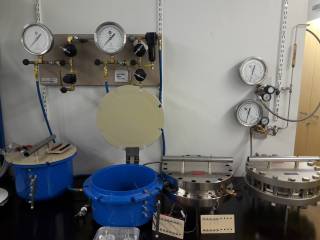 The aim of a pressure plate experiment is to determine the desorption curve of a capillary storage function. In the experiment a vacuum saturated sample is placed in the pressure plate extractor. The pressure forces the excess water out of the sample, until it has stabilised in the desired overpressure. Thus, the capillary pressure in the water-filled pores is the same as the pressure in the chamber. Once the sample has stabilised, it’s weighed, and the moisture content is calculated as a weight fraction from the result. The experiment is done in several different pressures, and since a certain capillary pressure corresponds to a certain relative humidity, a storage function can be determined for high values of relative humidity. However, the curve is usually presented as a function of average pore underpressure.
The aim of a pressure plate experiment is to determine the desorption curve of a capillary storage function. In the experiment a vacuum saturated sample is placed in the pressure plate extractor. The pressure forces the excess water out of the sample, until it has stabilised in the desired overpressure. Thus, the capillary pressure in the water-filled pores is the same as the pressure in the chamber. Once the sample has stabilised, it’s weighed, and the moisture content is calculated as a weight fraction from the result. The experiment is done in several different pressures, and since a certain capillary pressure corresponds to a certain relative humidity, a storage function can be determined for high values of relative humidity. However, the curve is usually presented as a function of average pore underpressure.
The samples used in the experiments have a diameter of 57 mm and a thickness of maximum 10 mm. The experiment is done in a (23 ± 1) °C temperature. The experiment is performed in pressures (and relative humidities corresponding to the pressure) 0,316 (99,977), 1,00 (99,927), 3,16 (99,77), 10,0 (99,27), 31,6 (97,7) and 100 bar (92,7 %RH). The levelling off of the moisture content can be followed either by monitoring the amount of water freed from the sample or by measuring the capacitance of the samples.
